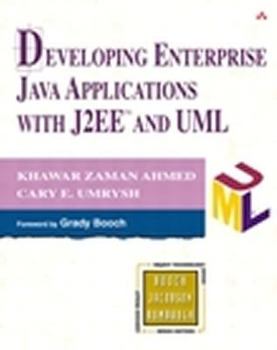Developing Enterprise Java Applications with J2ee? and UML
(Part of the Addison-Wesley Object Technology Series Series)
J2EE offers promise to the development community because it is particularly well-suited for building large-scale, robust applications for the entire enterprise. The Unified Modelling Language has... This description may be from another edition of this product.
Format:Paperback
Language:English
ISBN:0201738295
ISBN13:9780201738292
Release Date:January 2001
Publisher:Addison-Wesley Professional
Length:368 Pages
Weight:1.25 lbs.
Dimensions:0.7" x 7.3" x 9.3"
Customer Reviews
5 ratings
Good overview of UML -Java mapping
Published by Thriftbooks.com User , 22 years ago
This book has a good chapter 4 on UML-Java mapping which is explained very clearly. Other books tends to be bombastic and theorectical and vomitting out dry, useless high level UML jargons. Since most developers knows attrbutes and methods better than say, trying to figure out what an association link is, the mentioned chapter is invaluable. I wish the authors expanded more on UML-Java mapping as developer can then relate a diagram to the Java code. I would have given the book 5 star if it had expanded a bit on modelling XML and UML-Java mapping.
Not for code junkies
Published by Thriftbooks.com User , 22 years ago
This is a book I have been waiting for, a book explaining the relationship between J2EE and UML in practical terms. Whilst the information is not in depth, it is at the right level to explain the concepts clearly, and it gives practical examples. You won't find pages and pages of Java code. But you'll find a case study built up during the first 15 chapters, and nicely summarised in the final chapter.After a few introductory chapters, 5 chapters are devoted to explaining UML. Already familiar with UML, I skimmed through this, but still picked up good information. Particularly useful background was chapter 6, "Architecture".The more technical chapters, 9 to 15, explain the J2EE technology in the contect of UML. I found this well explained with just enough information, with no pages "wasted" on code listings. But some Java is present, showing how UML would map to code. The different components of J2EE each has a chapter devoted to them, and the relationships between them are discussed.All of the above is discussed in the context of RUP (Rational Unified Process), and the case study follows that process as well. The references to Conallen's WAE and the SUN standards are also very useful.The authors should be congratulated on writing a very clear, well-edited well-organised book.
Excellent Book - Great Work!
Published by Thriftbooks.com User , 22 years ago
Grady Booch wrote the foreward to this book where he speaks highly of these two authors, and I'd have to agree with his positive assessment. I don't often give out top ratings, but in this case I was fairly impressed.The book addresses these two key technologies and describes in very practical terms how to really use the UML to help create successful J2EE-based enterprise apps. Even though most of the chapters go into significant depth and detail, the book is stillvery readable by a wide audience. I think someone who is relatively new to either of these technologies would gain lotsfrom this book, and even near-gurus should be able to find many useful items here.The book covers UML modeling of Java servlets, JSP, and all current types of EJBs using the latest standards and extensions,including JSR-26 and WAE. Early chapters go through the UMLmapping for standard Java language constructs, and suggest a streamlined version of RUP used to develop the case study during the rest of the book. Different approaches used by popular UML modeling tools are shown, along with some ideas on future directions.I was impressed by the technology coverage for the different J2EE components. Through a close examination of the architecture and the different mechanisms at play, the reader learns a significant amount about how J2EE components such as EJBs work, how they're intended to be used, when they make sense to use, and when they don't. There's also discussions on performance, and some of the newer features in J2EE 1.3. Both J2EE 1.2 and the new J2EE 1.3 are covered, which amazed me given the amount of lead time a book like this needs to be published!Downloadable code for the case study is available from the publisher's site. The study is fairly compact, smaller than Sun's pet store example, but I found this enabled me to have an easier time following the code. What impressed me here is there is complete working code for both J2EE 1.3 and 1.2, and the example uses true container managed entity beans. Even Sun's pet store never seemed to get these EJBs working right.If a second edition of this book was to be written, I'd like to see discussions on more advanced patterns using combinations of J2EE components, additional performance enhancing techniques, and a larger case study using some of these advanced patterns.Overall, this was an excellent buy for me.
a nice light weight treatment of j2ee & uml
Published by Thriftbooks.com User , 23 years ago
this book gives a nice coherent detailed tutorial of j2ee and uml, and how to use the two together. it's a pleasant read.the treatment are concise and coherent, but somewhat light weight. it covers the most important concepts of both j2ee and uml. for modelling, it uses the wae and jsr26 uml extensions. it also follows a customized/simplified RUP process.the analysis and design chapters (chapter 7 & 8) are pretty good.the most significant drawback is the case study (chapter 16). it should have been elaborated more.overall, its a nice attempt trying to put j2ee & uml together!
Excellent work
Published by Thriftbooks.com User , 23 years ago
deep and practical guide for beginners and experts. A Must bible, highly recommandable






